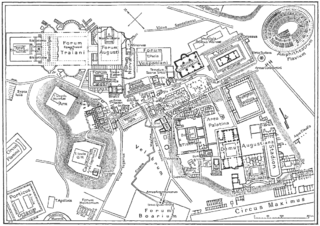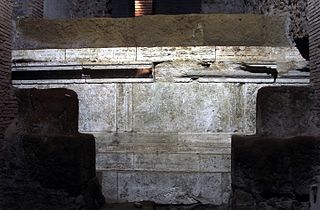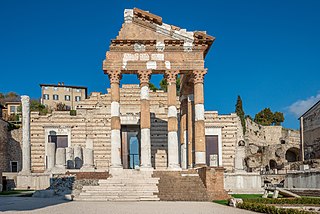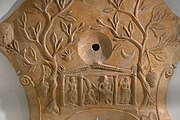
Minerva is the Roman goddess of wisdom, justice, law, victory, and the sponsor of arts, trade, and strategy. She is also a goddess of warfare, though with a focus on strategic warfare, rather than the violence of gods such as Mars. Beginning in the second century BC, the Romans equated her with the Greek goddess Athena. Minerva is one of the three Roman deities in the Capitoline Triad, along with Jupiter and Juno.

Jupiter, also known as Jove, is the god of the sky and thunder, and king of the gods in ancient Roman religion and mythology. Jupiter was the chief deity of Roman state religion throughout the Republican and Imperial eras, until Christianity became the dominant religion of the Empire. In Roman mythology, he negotiates with Numa Pompilius, the second king of Rome, to establish principles of Roman religion such as offering, or sacrifice.

In Roman mythology and religion, Quirinus is an early god of the Roman state. In Augustan Rome, Quirinus was also an epithet of Janus, as Janus Quirinus.

The Capitolium or Capitoline Hill, between the Forum and the Campus Martius, is one of the Seven Hills of Rome.

Vicus Tuscus was an ancient street in the city of Rome, running southwest out of the Roman Forum between the Basilica Julia and the Temple of Castor and Pollux towards the Forum Boarium and Circus Maximus via the west side of the Palatine Hill and Velabrum.

Religion in ancient Rome consisted of varying imperial and provincial religious practices, which were followed both by the people of Rome as well as those who were brought under its rule.
Festivals in ancient Rome were a very important part in Roman religious life during both the Republican and Imperial eras, and one of the primary feat of "holy days"; singular also feriae or dies ferialis) were either public (publicae) or private (privatae). State holidays were celebrated by the Roman people and received public funding. Games (ludi), such as the Ludi Apollinares, were not technically feriae, but the days on which they were celebrated were dies festi, holidays in the modern sense of days off work. Although feriae were paid for by the state, ludi were often funded by wealthy individuals. Feriae privatae were holidays celebrated in honor of private individuals or by families. This article deals only with public holidays, including rites celebrated by the state priests of Rome at temples, as well as celebrations by neighborhoods, families, and friends held simultaneously throughout Rome.

In Roman religion, Terminus was the god who protected boundary markers; his name was the Latin word for such a marker. Sacrifices were performed to sanctify each boundary stone, and landowners celebrated a festival called the "Terminalia" in Terminus' honor each year on February 23. The Temple of Jupiter Optimus Maximus on the Capitoline Hill was thought to have been built over a shrine to Terminus, and he was occasionally identified as an aspect of Jupiter under the name "Jupiter Terminalis".

Juno was an ancient Roman goddess, the protector and special counsellor of the state. She was equated to Hera, queen of the gods in Greek mythology and a goddess of love and marriage. A daughter of Saturn and Ops, she was the sister and wife of Jupiter and the mother of Mars, Vulcan, Bellona, Lucina and Juventas. Like Hera, her sacred animal was the peacock. Her Etruscan counterpart was Uni, and she was said to also watch over the women of Rome. As the patron goddess of Rome and the Roman Empire, Juno was called Regina ("Queen") and was a member of the Capitoline Triad, centered on the Capitoline Hill in Rome, and also including Jupiter, and Minerva, goddess of wisdom.

Ancient Roman temples were among the most important buildings in Roman culture, and some of the richest buildings in Roman architecture, though only a few survive in any sort of complete state. Today they remain "the most obvious symbol of Roman architecture". Their construction and maintenance was a major part of ancient Roman religion, and all towns of any importance had at least one main temple, as well as smaller shrines. The main room (cella) housed the cult image of the deity to whom the temple was dedicated, and often a table for supplementary offerings or libations and a small altar for incense. Behind the cella was a room, or rooms, used by temple attendants for storage of equipment and offerings. The ordinary worshiper rarely entered the cella, and most public ceremonies were performed outside of the cella where the sacrificial altar was located, on the portico, with a crowd gathered in the temple precinct.

A Capitolium (Latin) was an ancient Roman temple dedicated to the Capitoline Triad of gods Jupiter, Juno and Minerva. A capitolium was built on a prominent area in many cities in Italy and the Roman provinces, particularly during the Augustan and Julio-Claudian periods. Most had a triple cella, one for each god.

The Temple of Jupiter Optimus Maximus, also known as the Temple of Jupiter Capitolinus, was the most important temple in Ancient Rome, located on the Capitoline Hill. It was surrounded by the Area Capitolina, a precinct where numerous shrines, altars, statues and victory trophies were displayed.

The Temple of Veiovis in ancient Rome was the temple of the god Veiovis, built sometime in the early 1st century BC.

The Temple of Jupiter, Capitolium, or Temple of the Capitoline Triad, was a temple in Roman Pompeii, at the north end of its forum. Initially dedicated to Jupiter alone, it was built in the mid-2nd century BC at the same time as the Temple of Apollo was being renovated – this was the area at which Roman influence over Pompeii increased. So Roman Jupiter superseded the Greek Apollo as the town's leading divinity. Jupiter was the ruler of the gods and the protector of Rome, where his temple was the center of Roman religion and of the cult of state.

The Dii Consentes, also known as Di or Dei Consentes, or The Harmonious Gods, is an ancient list of twelve major deities, six gods and six goddesses, in the pantheon of Ancient Rome. Their gilt statues stood in the Roman Forum, and later apparently in the Porticus Deorum Consentium.
The Aventine Triad is a modern term for the joint cult of the Roman deities Ceres, Liber and Libera. The cult was established c. 493 BC within a sacred district (templum) on or near the Aventine Hill, traditionally associated with the Roman plebs. Later accounts describe the temple building and rites as "Greek" in style. Some modern historians describe the Aventine Triad as a plebeian parallel and self-conscious antithesis to the Archaic Triad of Jupiter, Mars and Quirinus and the later Capitoline Triad of Jupiter, Minerva and Juno. The Aventine Triad, temple and associated ludi served as a focus of plebeian identity, sometimes in opposition to Rome's original ruling elite, the patricians.

The Capitolium of Brixia or the Temple of the Capitoline Triad in Brescia was the main temple in the center of the Roman town of Brixia (Brescia), in Northern Italy, in the modern region of Lombardy. It is represented at present by fragmentary ruins, but is part of an archeological site, including a Roman theater and museum in central Brescia. It forms part of the Longobards in Italy: Places of Power UNESCO World Heritage Site inscribed in 2011.

The Capitolium of Constantinople was a public edifice erected in Constantinople by Emperor Constantine the Great. Founded as a capitolium, in the fifth century it was turned into an institute of higher education.




















